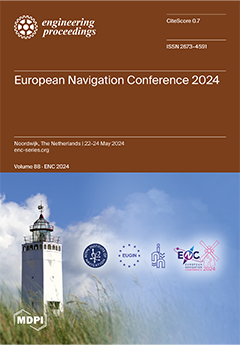Open AccessProceeding Paper
Galileo Timing Receiver Standard
by
Héctor Llorca, Javier Fidalgo, Ricardo Píriz, Javier Bárcena, Francisco Arribas, Valeria Catalano, Gert-Jan Pauwels, Joaquim Fortuny, Beatrice Motella, Javier Tegedor, Matteo Sgammini, Miguel Aguilera, Juan Pablo Boyero and Tom Willems
Viewed by 910
Abstract
The European Commission (EC) is taking steps towards the implementation of a Galileo Timing Service. This service is now formally part of the mission of the Galileo Second Generation, and it puts emphasis on serving critical infrastructure. Implementing a proper service implies putting
[...] Read more.
The European Commission (EC) is taking steps towards the implementation of a Galileo Timing Service. This service is now formally part of the mission of the Galileo Second Generation, and it puts emphasis on serving critical infrastructure. Implementing a proper service implies putting all the necessary elements in place to be able to meet the defined level of performance. In order to ensure the correct processing of the service’s signals and a minimum level of performance of the user receiver, corresponding standards are needed. Therefore, a fundamental element in the Galileo Timing Service concept is the standardization of Galileo Timing Receivers. The STARLITE project (Preparation of Standards for Galileo Timing Receivers) funded by the EC is the first international initiative to develop standards for GNSS Timing Receivers. The target users for the standard are all Galileo Timing users, with a special focus on critical infrastructure within the telecommunications, finance and energy sectors. The standard leverages the specificities of the Galileo Timing Service. This will become fundamental in order to ensure the end-to-end performance for those users operating a receiver compliant with the standard. At the same time, the standard allows the use of other systems to further enhance the performance. The project helped to establish a formal Working Group (WG9) for the development of the standard under CEN/CENELEC JTC5.
Full article
►▼
Show Figures




